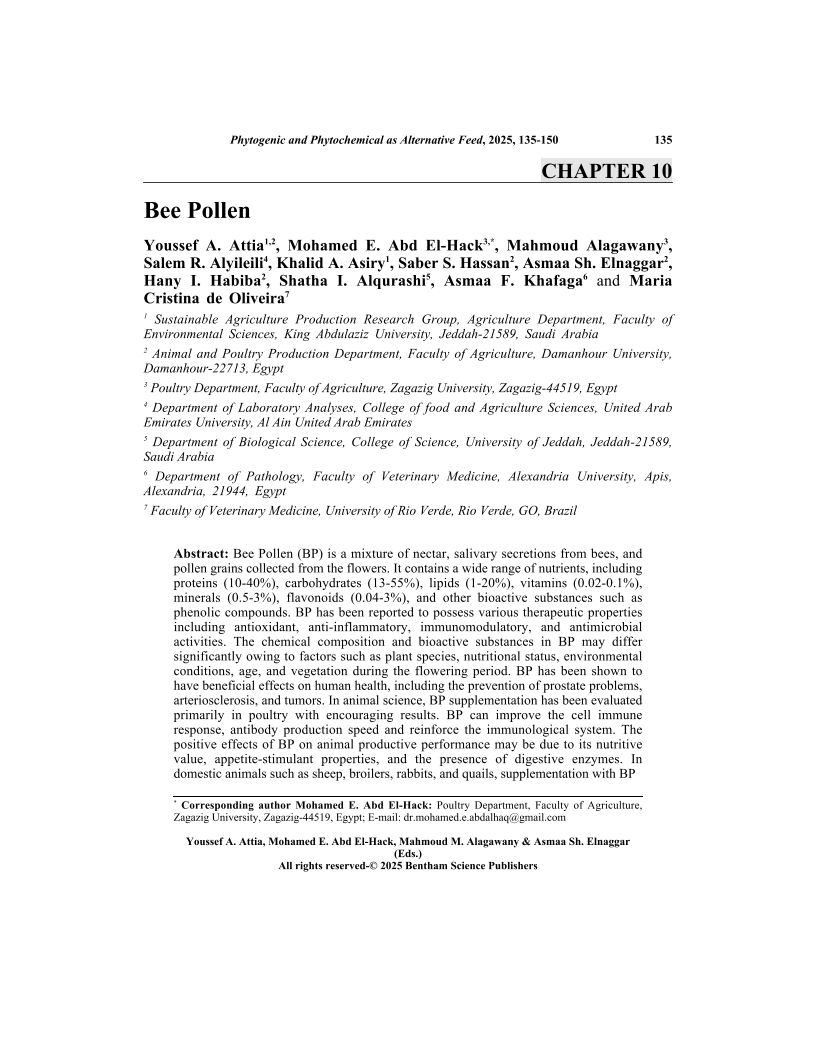Bee Pollen

- Authors: Youssef A. Attia1, Mohamed E. Abd El-Hack2, Mahmoud Alagawany3, Salem R. Alyileili4, Khalid A. Asiry5, Saber S. Hassan6, Asmaa Sh. Elnaggar7, Hany I. Habiba8, Shatha I. Alqurashi9, Asmaa F. Khafaga10, Maria Cristina de Oliveira11
-
View Affiliations Hide Affiliations1 Sustainable Agriculture Production Research Group, Agriculture Department, Faculty of Environmental Sciences, King Abdulaziz University, Jeddah 21589, Saudi Arabia 2 Poultry Department, Faculty of Agriculture, Zagazig University, Zagazig-44519, Egypt 3 Poultry Department, Faculty of Agriculture, Zagazig University, Zagazig-44519, Egypt 4 Department of Laboratory Analyses, College of food and Agriculture Sciences, United Arab Emirates University, Al Ain United Arab Emirates 5 Sustainable Agriculture Production Research Group, Agriculture Department, Faculty of Environmental Sciences, King Abdulaziz University, Jeddah-21589, Saudi Arabia 6 Animal and Poultry Production Department, Faculty of Agriculture, Damanhour University, Damanhour-22713, Egypt 7 Animal and Poultry Production Department, Faculty of Agriculture, Damanhour University, Damanhour-22713, Egypt 8 Animal and Poultry Production Department, Faculty of Agriculture, Damanhour University, Damanhour-22713, Egypt 9 Department of Biological Science, College of Science, University of Jeddah, Jeddah-21589, Saudi Arabia 10 Department of Pathology, Faculty of Veterinary Medicine, Alexandria University, Apis, Alexandria, 21944, Egypt 11 Faculty of Veterinary Medicine, University of Rio Verde, Rio Verde, GO, Brazil
- Source: Phytogenic and Phytochemical as Alternative Feed Additives for Animal Production , pp 135-150
- Publication Date: March 2025
- Language: English
Bee Pollen, Page 1 of 1
< Previous page | Next page > /docserver/preview/fulltext/9789815322767/chapter-10-1.gif
Bee Pollen (BP) is a mixture of nectar, salivary secretions from bees, and pollen grains collected from the flowers. It contains a wide range of nutrients, including proteins (10-40%), carbohydrates (13-55%), lipids (1-20%), vitamins (0.02-0.1%), minerals (0.5-3%), flavonoids (0.04-3%), and other bioactive substances such as phenolic compounds. BP has been reported to possess various therapeutic properties including antioxidant, anti-inflammatory, immunomodulatory, and antimicrobial activities. The chemical composition and bioactive substances in BP may differ significantly owing to factors such as plant species, nutritional status, environmental conditions, age, and vegetation during the flowering period. BP has been shown to have beneficial effects on human health, including the prevention of prostate problems, arteriosclerosis, and tumors. In animal science, BP supplementation has been evaluated primarily in poultry with encouraging results. BP can improve the cell immune response, antibody production speed and reinforce the immunological system. The positive effects of BP on animal productive performance may be due to its nutritive value, appetite-stimulant properties, and the presence of digestive enzymes. In domestic animals such as sheep, broilers, rabbits, and quails, supplementation with BP has been reported to improve the immune response, increase feed digestibility, reduce oxidative stress, and improve animal performance. This chapter emphasizes the use of Bee Pollen in livestock nutrition as a feed supplement to improve productive performance as an eco-friendly alternative to antibiotics.
-
From This Site
/content/books/9789815322767.chapter-10dcterms_subject,pub_keyword-contentType:Journal -contentType:Figure -contentType:Table -contentType:SupplementaryData105

